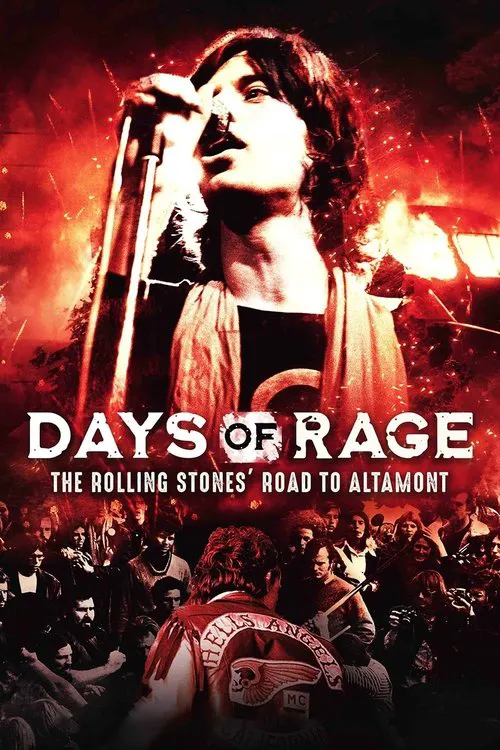Days of Rage: The Rolling Stones' Road to Altamont

Plot
The late 1960s, a time when the air was thick with the anticipation of change and revolution. This era, born out of a desire for peace, love, and social equality, was rapidly unravelling amidst chaos and bloodshed. The world was witnessing a series of catastrophic events that would forever alter the course of history. It was amidst this turbulent backdrop that the Rolling Stones emerged as the iconic voice of a generation, singing the blues and anthems that defined a new era. The year was 1969, and the Rolling Stones were at the height of their fame. They had released their groundbreaking album 'Beggars Banquet' the previous year, pushing the boundaries of rock music and cementing their status as one of the most influential bands of all time. The album's themes of rebellion, social commentary, and dark humor resonated deeply with the youth of the time, who were increasingly disillusioned with the establishment. As the Stones embarked on their 1969 US tour, the tension and energy surrounding the band grew exponentially. Their concerts became a reflection of the growing unrest in the nation, with fans mirroring the frustration and anxiety that was gripping the country. The assassination of Martin Luther King Jr. in April 1968, the protests against the Vietnam War, and the subsequent riots had created a sense of disillusionment that was palpable across the nation. The Stones' tour was scheduled to culminate in a three-day concert at the Altamont Speedway in Northern California, in what would become one of the most infamous music festivals in history. The Altamont Free Concert, as it was officially billed, was meant to be a utopian gathering, a celebration of peace, love, and rock 'n' roll. But beneath the surface, the events unfolding at the festival would prove to be a cautionary tale of the darker forces that were at work in the world. As the Stones prepared to take the stage at Altamont, the tensions between the band and the local authorities had been escalating for weeks. The San Francisco Bay Area was a hotbed of counterculture activity, and the Hells Angels motorcycle club, who were supposed to provide security at the festival, were notorious for their involvement in violent gang activity. On the day of the festival, thousands of fans converged on the Altamont Speedway, a barren stretch of land that had once been a horse racing track. The Hells Angels, dressed in their signature black leather jackets and sporting menacing scowls, mingled with the crowd, their presence a stark reminder of the lawlessness that seemed to be spreading across the nation. As the day wore on, the sense of unease grew. A series of skirmishes broke out between members of the Hells Angels and rival gangs, and the smell of fear and uncertainty hung in the air. Despite the ominous atmosphere, the music continued to play, with acts like Santana and the Grateful Dead drawing huge crowds and delivering blistering performances. But as the night wore on, the situation at Altamont began to spiral out of control. A young African American man named Meredith Hunter, who had been trying to get backstage to see the Stones, was stabbed to death by a Hells Angel while trying to protect his sister. The incident sparked a chain reaction of violence and chaos that would forever be etched in the memory of those who were present. The Stones, oblivious to the unfolding carnage, took to the stage and delivered a blistering performance that would become one of the greatest in rock history. As they launched into their set, the crowd erupted into a frenzy of noise and emotion, but beneath the surface, the darkness of Altamont was beginning to reveal itself. The image of a young girl crying as she watched the Hells Angels beating up a man on stage has become an enduring symbol of the festival's tragedy. It is a moment that captures the sense of disillusionment and despair that had taken hold of a generation. The Altamont Free Concert was meant to be a celebration of peace and love, but in the end, it became a symbol of the chaos and bloodshed that would define the late 1960s. As the festival finally came to a close, the Rolling Stones were left to grapple with the aftermath of the tragedy. Meredith Hunter's death was a stark reminder of the cost of the chaos that had been unleashed on the world. The band had inadvertently become complicit in the violence that had unfolded at Altamont, their music a soundtrack to the chaos that had consumed the nation. In the years that followed, the Rolling Stones would continue to tour and record music, but they would never fully shake off the weight of the events that had transpired at Altamont. The tragedy of the festival would forever be etched in the memory of the band and their fans, a haunting reminder of the darker forces that had driven the course of history. Despite the darkness that would follow, the Rolling Stones would find a way to transcend the tragedy of Altamont, using their music to speak to a new generation of activists and artists who were searching for a way out of the chaos. They would go on to release some of their greatest work in the following years, music that would capture the mood of a nation in crisis. But on that fateful night in December 1969, the world was witness to a moment of utter devastation, a sense of destruction that would haunt the collective memory of a generation. The Altamont Free Concert was meant to be a celebration of peace, love, and rock 'n' roll, but in the end, it became a dark reminder of the chaos and bloodshed that defined the late 1960s.
Reviews
Recommendations




